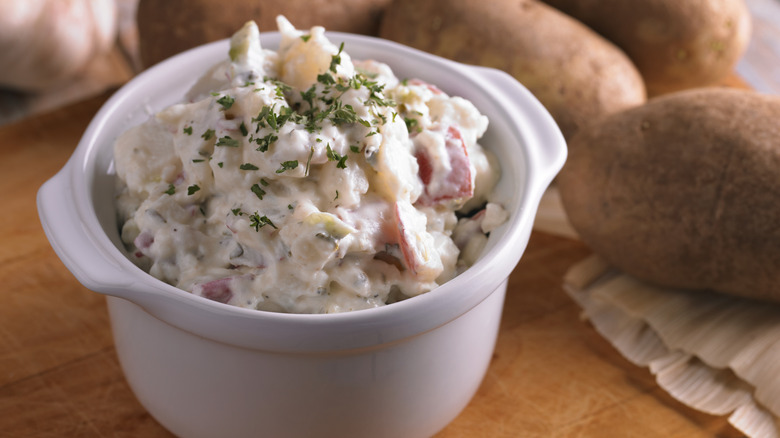One Simple Swap For Creamy Potato Salad Without Mayo
If you're whipping up potato salad and don't have mayonnaise on hand, or you'd just prefer a dressing that's a little less oily, there's one formidable alternative out there: Yogurt. This dairy product is a fairly popular alternative to mayo — some cooks praise it as a healthier alternative, but this swap isn't a case of subbing in an inferior imitation just in the name of cutting some calories. With a similar texture and a relatively neutral flavor, it's not wildly different from mayonnaise, although it does have a slightly tangier taste to it — some cooks prefer this, since yogurt arguably has a brighter, more summery taste than mayo, making it particularly well-suited for this kind of hot weather side dish.
Specifically, you'll probably want to use Greek yogurt. Since it's strained, it's a lot thicker than other yogurt varieties, so it'll stick to the potato pieces better (although it may cost you a little more). While you could try with non-Greek yogurt, you may run the risk of it pooling at the bottom of your potato salad dish, depending on how thin it is. Whatever you do, just make sure it's plain yogurt: It's highly unlikely your dinner guests will appreciate a potato salad with sugary strawberry or mango flavors mixed throughout.
The differences to expect from Greek yogurt instead of mayo
Although they're somewhat similar-looking, the properties of Greek yogurt and mayo are pretty different. Mayonnaise is very fatty — like, ¾ fat, compared to Greek yogurt, which varies but doesn't usually go above 10% fat. The yogurt will instead add a solid hit of protein — these two differences are why it's often held up as a healthier alternative. While they're both fairly neutral flavors, mayo is more likely to have an eggy note to it — check the ingredient list, too, as some mayos (for example, Japan's Kewpie mayo) will have a stronger flavor due to extra ingredients. Greek yogurt, on the other hand, will be more down-the-line tart or tangy, with a creaminess and no added salt.
Those relatively neutral tastes mean they'll play well with other seasonings and flavors you might use in a potato salad dressing, be it lemon, mustard, green onions, or fresh herbs. Because of the oilier profile of mayonnaise, some recipes tend to recommend throwing in sharper-tasting ingredients like capers or herbs to cut through the heavy dressing. If you're using Greek yogurt, there's no need to drop these extras (after all, they also add considerable flavor), but just be aware that you're working with a brighter, tangier base, so you may want to start with less and add more as you see fit.
How to use Greek yogurt instead of mayo
There's no one magic number to help you swap out mayo for Greek yogurt: Different potato salad recipes call for different proportions of mayo, and the same goes for recipes that use yogurt. That said, it does seem that some recipes will call for a little more Greek yogurt as compared to mayo — mayonnaise recipes will usually stick around a half-cup of mayo for each pound of potatoes, while yogurt recipes may go higher, but not always. Really, it's about personal preference — if you want a heavily-dressed salad, use more. If you want the best of both worlds, consider a half-half mix of mayonnaise and yogurt.
You'll want to be more careful to ensure your potatoes are cooled after cooking if you're using yogurt: Heat can make the yogurt separate and curdle, which won't make for the most appetizing final product.
This swap isn't just for potato salad, either — you can also try it out in comparable recipes with mayo dressings, like chicken or egg salad. But be aware that Greek yogurt and mayo aren't always interchangeable: They may swap out well for potato salad, but you wouldn't want to try substituting yogurt with mayonnaise in baking.


